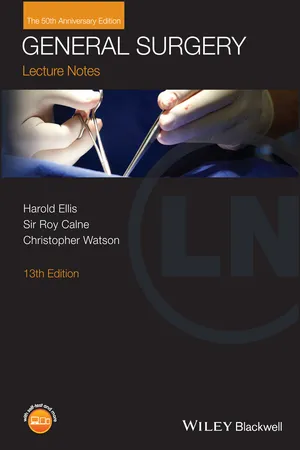
- English
- ePUB (mobile friendly)
- Available on iOS & Android
General Surgery
About this book
THE 'GOLDEN JUBILEE' EDITION OF A CLASSIC TEXTBOOK, FIRST PUBLISHED IN 1965
Highly Commended at the British Medical Association Book Awards 2016
General Surgery Lecture Notes continues to be an invaluable, appealing and approachable resource for thousands of medical students and surgical trainees throughout the world. This comprehensive guide focuses on the fundamentals of general surgery, and systematically covers all the clinical surgical problems that a student may encounter and about which they need to know.
Fully revised and updated to reflect the rapid changes which are taking place in surgical practice, this 50th anniversary edition:
- Includes principles of treatment written at student level to aid understanding
- Features full colour illustrations throughout
- Includes electronic access to a range of extra material including case studies, images and photographs, and biographies
- Includes free access to the Wiley E-Text
- Is a perfect review text for medical students as well as junior surgeons taking the MRCS examination and other postgraduate surgical examinations
Trusted by generations of medical students, the clinical emphasis of General Surgery Lecture Notes makes this an essential purchase for all those wishing to learn more about general surgery.
Frequently asked questions
- Essential is ideal for learners and professionals who enjoy exploring a wide range of subjects. Access the Essential Library with 800,000+ trusted titles and best-sellers across business, personal growth, and the humanities. Includes unlimited reading time and Standard Read Aloud voice.
- Complete: Perfect for advanced learners and researchers needing full, unrestricted access. Unlock 1.4M+ books across hundreds of subjects, including academic and specialized titles. The Complete Plan also includes advanced features like Premium Read Aloud and Research Assistant.
Please note we cannot support devices running on iOS 13 and Android 7 or earlier. Learn more about using the app.
Information
1
Surgical strategy
Learning objectives
- √ To understand the principles of taking a clear history, performing an appropriate examination, presenting the findings and formulating a management plan for surgical diagnosis.
- √ To understand the common nomenclature used in surgery.
- History taking. Listen carefully to the patient’s story.
- Examination of the patient.
- Writing notes.
- Constructing a differential diagnosis. Ask the question ‘What diagnosis would best explain this clinical picture?’
- Special investigations. Which laboratory and imaging tests are required to confirm or refute the clinical diagnosis?
- Management. Decide on the management of the patient. Remember that this will include reassurance, relief of pain and, as far as possible, allaying the patient’s anxiety.
History and examination
The history
| Pain | Rectal bleeding |
| Exact site | Estimation of amount (often inaccurate) |
| Radiation | Timing of bleeding |
| Length of history | Colour – bright red, dark red, black |
| Periodicity | Accompanying symptoms – pain, vomiting (haematemesis) |
| Nature – constant/colicky | Associated features – fainting, shock, etc. |
| Severity | Blood mixed in stool, lying on surface, on paper, in toilet pan |
| Relieving and aggravating factors | |
| Accompanying features (e.g. jaundice, vomiting, haematuria) |
Table of contents
- Cover
- Titlepage
- Copyright
- Preface
- Acknowledgements
- Abbreviations
- The anytime, anywhere textbook
- About the companion website
- 1: Surgical strategy
- 2: Fluid and nutrition management
- 3: Preoperative assessment
- 4: Postoperative complications
- 5: Acute infections
- 6: Tumours
- 7: Shock
- 8: Burns
- 9: The skin and its adnexae
- 10: The chest and lungs
- 11: The heart and thoracic aorta
- 12: Arterial disease
- 13: Venous disorders of the lower limb
- 14: The brain and meninges
- 15: Head injury
- 16: The spine
- 17: Peripheral nerve injuries
- 18: The oral cavity
- 19: The salivary glands
- 20: The oesophagus
- 21: The stomach and duodenum
- 22: Mechanical intestinal obstruction
- 23: Paralytic ileus
- 24: The small intestine
- 25: Acute appendicitis
- 26: The colon
- 27: The rectum and anal canal
- 28: Peritonitis
- 29: Hernia
- 30: The liver
- 31: The gallbladder and bile ducts
- 32: The pancreas
- 33: The spleen
- 34: The lymph nodes and lymphatics
- 35: The breast
- 36: The neck
- 37: The thyroid
- 38: The parathyroids
- 39: The thymus
- 40: The adrenal glands
- 41: The kidney and ureter
- 42: The bladder
- 43: The prostate
- 44: The male urethra
- 45: The penis
- 46: The testis and scrotum
- 47: Transplantation surgery
- Index
- Biographies
- Eponyms